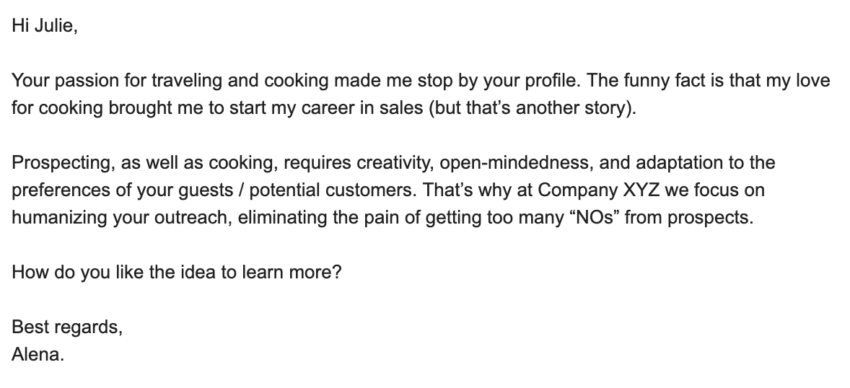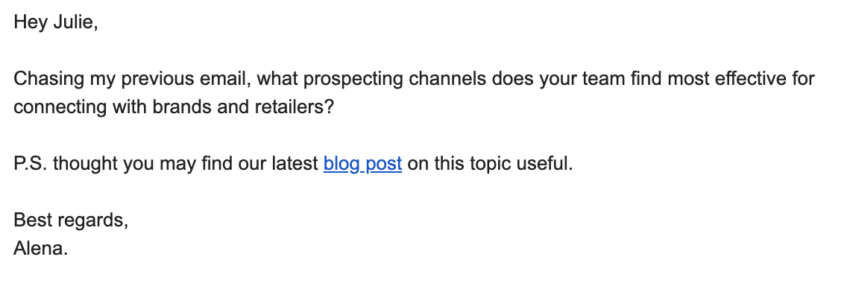How Personalization Improves Results in Sales Outreach in 2021?
What drives our growth more than our experience?
Where would we be without these moments of total failure?
I remember those times when I felt utterly devastated.
Five years ago, I got my first sales job in tech.
The company developed an open-source IoT platform and started to play big, targeting tech giants like Bosch, IBM, 3M, etc. This meant: super-advanced tech, strict requirements for clients, an extremely complex buying process, and no room for error. And, most importantly, little to zero experience with prospecting into enterprise accounts, lack of clear strategy, and high expectations from a group of the other newbies like me.
Here we go.
My team and I were given a bunch of templates. Of course, all of them mentioned 20+ years of our software development experience, described our product with dozens of buzzwords, included a list of cool features and advantages, listed a bunch of industries we had experience with, and asked for a time commitment right away.
As a first-time rep, have I thought about providing value first or engaging with a prospect on a human level?
Did I understand the importance of building relationships when working with enterprise accounts?
Unfortunately, that answer was a resounding “no.”
What I needed at the moment was to push harder every day to find more target companies, research more prospects, send more emails, and then pray that luck was on my side.
This approach worked some days, and I managed to schedule calls for 3–5 people on the customer side, our CTO, and VP of Sales. On the other days, I received dozens of responses like: “not interested,” “never contact me again,” or “delete me from your list.” One way or another, a 5% response rate and 1–2% conversion into meetings did not let me sleep well at night.
My #1 challenge was finding the reason why my messages did not resonate with the audience.
I wish this understanding would have come in a month or two. But, it took me a lot of time, self-blame, and missed opportunities before I was able to unfold the WHY, which was hidden beneath a bunch of mistakes:
- Adding surface personalization without any connection to my value offering
- Using funding information to trigger a conversation (or in other words: I’m coming after your money)
- Jumping right into selling mode, focusing on us, our product, and its capabilities
- Not adjusting my messages to different titles — same messages and value offering for CTO, COO, Engineering managers, or CEOs
- Sending follow-ups only to pop up in the inbox one more time
- Pushing for a call in every single message
Thankfully, my consistent and thoughtful approach to research sowed the seeds for my future transformation. (P.S. It was around when the term “personalization” first caught my attention across social media).
I started to think about personalization as the best way to apply the data found on personal, professional, and company levels. The creative and authentic way to:
- Connect with a person on a level much more in-depth than “I hope you’re doing well.”
- Differentiate yourself from the crowd (based on conversations I had, only 10–20% of emails are authentic and relevant).
- Gain trust from the beginning instead of pitching and asking for a call—showing your intention to go the extra mile to start a dialogue.
After continuous practice and preaching, my current process looks like this:
Step 1: Research
For research, there are three main areas to look at: the prospect’s LinkedIn profile, the company’s LinkedIn page, and the company’s website.
When scanning the prospect’s LinkedIn profile, I try to pay extra attention to such data:
- Headline : People love to summarize their mission in the most concise way.
- About section : It’s the perfect place to find some info about the prospect’s personal values, goals, and accomplishments.
- Experience : I try to dive deeper into the overall career path, as well as into particular areas of responsibility in the company that interests me
- Activity : Is my prospect creating content? If they are, what’s it about? What type of content do they like and engage with?
The LinkedIn company page contains some additional info that I can use in my opening line:
- Company updates: Look for posts on events, new office openings, rewards, listings, etc.
- Hiring information : What roles are they trying to fill? Do some of the positions intersect with my solution/expertise?
- “Life” section : This gives a sneak peek of the company culture, openly showing testimonials from their employees.
The website tells their story from different angles. Mission, values, solutions, team, customers, success stories — every single component is a small piece that forms a single picture.
Step 2 : Outreach
I write my emails in a way to answer these three questions:
- What’s the reason for my outreach? This gives my prospects an idea of what triggered me to connect with them.
- What challenges can I help my prospects overcome? This shows the alignment between their goals and my solution.
- What is the most logical next step? This makes it easy for them to react.
Here is an example:

Step 3 : Follow-Up
For me, a follow-up strategy is an area perfect for experimentation.
Sometimes, I use them to add something valuable to my previous message. In other cases, I write them as short reminders, the purpose of which is:
- Educate my prospects : Relevant content, either my own or third-party, is an essential part of my follow-ups.
- Engage them in a dialogue : I love questions; they are way less annoying than statements!
A quick example:

So, how did my transformation improve my results?
During the last five years, besides my approach, my target audience and solution have also changed; and, numbers speak better than words. They can give a general idea of how my results evolved and improved.
Old strategy:
100 prospects → 5% response rate (5 replies)→ 1–2% conversion into meetings (1–2 meetings)
Current approach:
100 prospects -> 20% response rate (20 replies)-> 6% conversion into meetings (6 meetings)
Conclusion
It’s never been easy to find the right way to connect with prospects online from day 1. You cannot read their emotions, see their body language, and the first reaction to what you’re saying.
You learn on the go.
When you have some doubts about a specific approach, there is one key thing to do—something that took me so long to figure out — catch the moment when your gut feelings and numbers push you to make a pivot.
Prospecting requires continuous creativity and A/B testing. Even the smallest change in phrasing or email structure can bring game-changing results.
Throughout my path, what helped me is following content from sales leaders who are not afraid to roll up their sleeves and always dig deeper, experiment, and share their results. Extra motivation is the best nudge 🙂
By sharing my story, I encourage you never to stop exploring new approaches and keep rocking your prospecting!